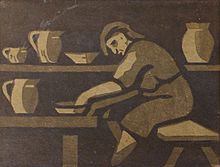Joanna Konarzewska
Joanna Konarzewska (born December 18, 1926 in Rybnik , Upper Silesia , † June 16, 1991 in Zbrosławice near Tarnowskie Góry , Poland ) was a Polish painter , graphic artist , interior designer and art teacher. She came from a family of craftsmen and merchants, was the daughter of Maria and Rajmund Jonderko and the wife of the painter and sculptor Ludwik Konarzewski Jr.
Life
Konarzewska studied graphics in Katowice from 1952–1958 at the then branch of the Krakow Art Academy, among others with the graphic artist Aleksander Rak, who was born in Odessa , later lived in Kiev and finally settled in Silesia after the Second World War. As a graphic artist, she painted portraits and occasionally nature images on which she interpreted the landscape of Upper Silesia very personally. For the graphics she used the technique of lithography, wood carving and various metal techniques. In later times she created works in oils, most often landscapes, portraits and still lifes, as well as watercolor and pastel paintings, which reflected the personal fascination that the lake and mountain landscape exerted on her.
From 1959 to 1983 Konarzewska toured Western Europe and the United States. During this time her interest in interior design developed. As an example of this element of their work, rooms in the cultural center in Rydułtowy near Rybnik, which at that time was under the management of the coal mine called “Rydułtowy-Anna”, can serve. The work was completed around 1960. In the independent and original interior design of these rooms one can find a clear reference to the works of such contemporary artists as Joan Miró , Alexander Calder , Paul Klee or to the paintings of Henri Matisse , one of the creators of the art cannon in the 20th century. The visual arts in the second half of the 20th century worked mainly through their form and less often through their content. Thereby she fulfilled a pioneering function in the applied arts. As is often the case with public places, the interior fittings from the Rydułtowy Cultural Center have unfortunately not been preserved.
In the 1950s she and her husband Ludwik taught painting, graphics and drawing in a non-profit art center next to their own house on the family property called Bucznik in Istebna . From 1958–1968 she taught art at the State Center for Fine Arts in Rydułtowy, which was founded by her husband and his father. From 1970 to 1976 Konarzewska was a teacher of fine arts at secondary schools in Cieszyn Silesia . In class, she particularly emphasized the importance of applied art and the entire material culture in everyday human life. The nature and scope of art education was quite innovative in what was then Poland and contributed to Konarzewska's success as a teacher, as the classes markedly increased the aesthetic awareness of young people.
In the 70s and 80s she took part in local, regional and national exhibitions in Katowice, Rybnik and Bielitz-Biala as well as in exhibitions abroad - in Hamburg and Cologne .
References
Movie
- Gniazdo na Buczniku - documentary, director: Aleksandra Dendor, TVP / Center in Kattowitz 1993; broadcast in 1994 in TVP 3 and TVP 2
literature
- Zofia Bożek: Sylwetki twórców i popularyzatorów sztuki województwa bielskiego. Dictionary. Bielsko-Biała 1987, ISBN 83-7004-019-5 , p. 51.
- Łukasz Konarzewski: Joanna Konarzewska, czyli kwiaty śląskie ( Joanna Konarzewska, that is, Silesian flowers ) In: Znad Olzy. (Writing on culture and society) Volume IV No. 3 (19), May – June, 2001, ISSN 1506-3992 , pp. 1 and 10.
- E. Rosner: Istebniańskie spotkania - wizyta u Konarzewskich. In: Głos Ziemi Cieszyńskiej. (Regional weekly) No. 30 of August 2, 1957.
Individual evidence
- ↑ biblioteka.info
- ↑ a b Łukasz Konarzewski: Joanna Konarzewska, czyli kwiaty śląskie. In: Znad Olzy. Volume IV No. 3 (19) May June, 2001, pp. 1 and 10, passim
- ↑ a b Zofia Bożek, Sylwetki twórców i popularyzatorów sztuki i województwa bielskiego , Bielsko-Biała, 1987, p. 51.
- ↑ What has been preserved is a documentation of the interior in the form of color photos from that time. One picture is attached to this post, the others were partly used for the article “Joanna Konarzewska, which means Silesian flowers”.
- ↑ pop-rydultowy.pl
| personal data | |
|---|---|
| SURNAME | Konarzewska, Joanna |
| BRIEF DESCRIPTION | Polish painter, graphic artist, interior designer and art teacher |
| DATE OF BIRTH | December 18, 1926 |
| PLACE OF BIRTH | Rybnik , Upper Silesia |
| DATE OF DEATH | June 16, 1991 |
| Place of death | Zbrosławice near Tarnowskie Góry , Poland |


